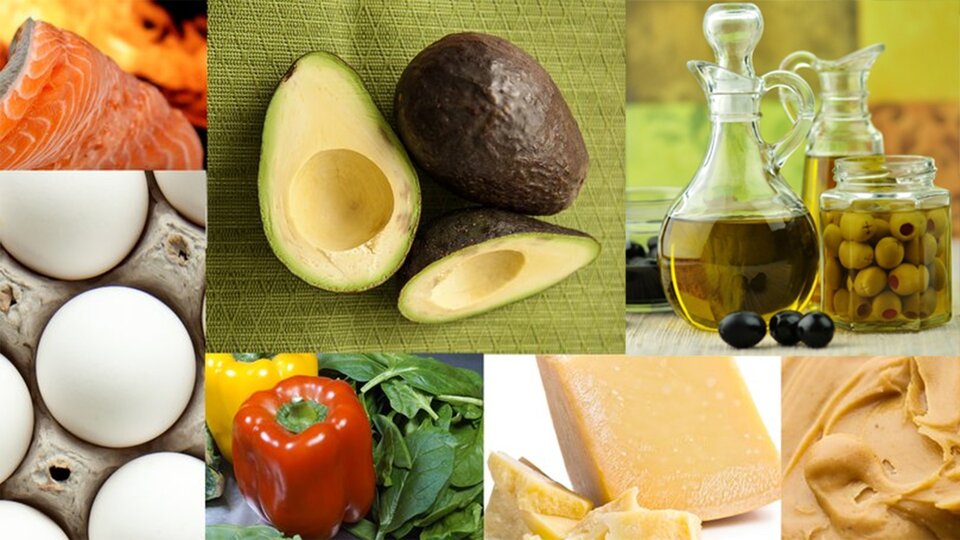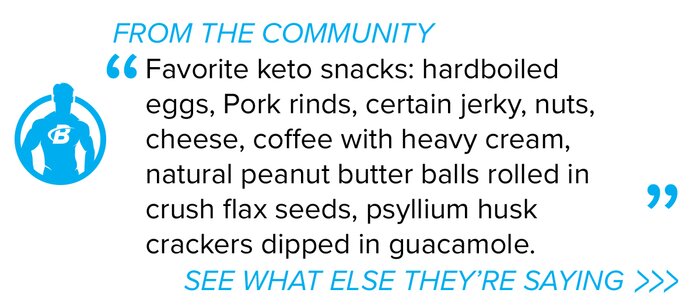Products You May Like
How Keto Works | Keto Meal Plan | Keto for Weight Loss | Keto for Muscle Gain | Keto Mistakes & Side Effects | Best Keto Supplements
You’ve heard the arguments, weighed out the challenges and benefits, and decided you’re all in: You’re going keto.
More people than ever are embracing this very low-carb, high-fat diet plan and sticking with it for months or even years. Once they successfully make the switch from using carbohydrates to using fat and ketones for fuel, they find they’re leaner, healthier, and more mentally focused than ever.
But for every lifter who ends up loving the ketogenic diet, you’ll find another who had a miserable experience and bailed after just a few days. This is a shame, because they probably could have felt great if they had simply had a better plan—or a plan at all.
Here’s what you need to know—including keto meals and a keto food list—to ace your nutrition and supplementation during the crucial first month of ketogenic dieting.
Your Must-Have (and Must-Not-Have) Keto Food List
Ready to head out the door and start buying your keto foods? First get rid of foods that don’t fit with keto. This means any food with a significant carb content, including fruit. Even carrots and onions are too high-glycemic to work with keto.
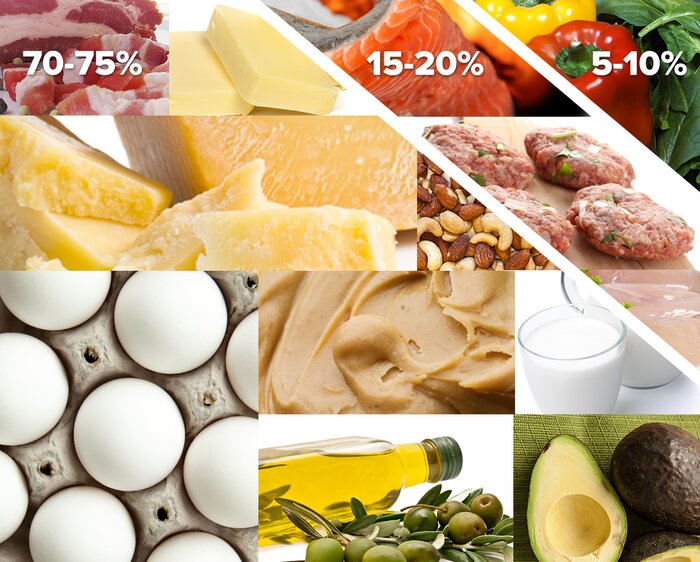
Healthy snack options can be hard to find on a keto diet. Kill your carb cravings with these delicious low-carb snacks!
Now that your cupboards are bare, here are some of the staple keto diet foods you should build your ketogenic diet around:
- Fatty nuts and seeds: cashews, macadamia nuts, pumpkin seeds
- Avocado
- Whole eggs
- Full-fat cheese
- Beef: ground chuck (80/20), filet mignon, porterhouse, ribeye
- Chicken: Thighs and legs
- Vegetables: spinach and other greens, broccoli, asparagus, cabbage, mushrooms, bell pepper
- Pork rinds
- Olive oil
- Salted butter
- Heavy cream
- Sour cream
- Cream cheese
- Fatty fish: salmon, mackerel, sardines, anchovies
- Bacon
- Chicken broth or bouillon cubes with at least 1 gram of sodium
That last item may surprise you, but for many people, it makes all the difference. Why? When carbs are cut, we rapidly deplete glycogen. For every gram of glycogen we lose, we lose 3 grams of water. Drinking bouillon broth will help prevent dehydration and improve the way you feel on the diet. Water isn’t enough on keto; you need enough sodium, too.
Want even more guidance? Teryn Sapper, MS, lead registered dietician for the Department of Human Sciences at The Ohio State University, has written out a sample meal plan to get you up and running.
Keto Meal Plan for Beginners
Breakfast Option 1: Fried Eggs with Sautéed Veggies and Bacon
Cook two slices of bacon and set aside. Sauté 1/2 cup of sliced mushrooms in the bacon grease, adding 3/4 cup spinach at the very end to cook slightly. Serve sautéed veggies and bacon with 2 eggs fried in butter.
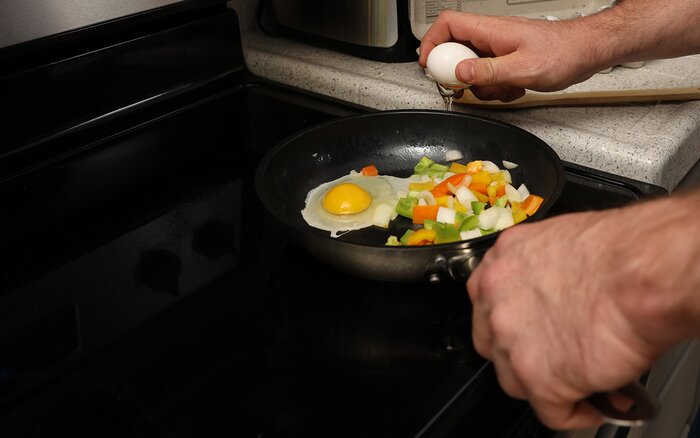
Breakfast Option 2: The ”No Egg” Breakfast
Cook 1 ounce of sausage (check the label to make sure it’s sugar-free) according to the package directions. Sauté 1 cup of chopped bell pepper in 1 tablespoon of olive oil, then serve with the sausage sprinkled with 1 ounce of shredded cheese.
Lunch Option 1: Taco Salad
Cook 3 ounces of 80/20 ground beef with 2 teaspoons of taco seasoning. Serve with 2 cups of shredded romaine lettuce, sliced cherry tomatoes, 1.5 ounces of shredded cheese, 1/4 an avocado, and 1/4 cup of sour cream.
Lunch Option 2: BLT Lettuce Wrap
Spread 2 tablespoons of mayonnaise on three large romaine leaves, using them to wrap 2 ounces of grilled chicken and six slices of cooked bacon. Top with sliced cherry tomatoes and 1 ounce of shredded cheese.
Dinner Option 1: Pork Chop with Mushroom Sauce and Steamed Asparagus
Cook a 4-ounce pork chop. Sauté 3/4 cup of sliced mushrooms in a pan with butter and olive oil. Add 1 teaspoon of mixed garlic, 1 pinch of thyme, and 3 tablespoons of heavy whipping cream. Pour sauce over pork chop and serve with 1/2 cup steamed asparagus.
Dinner Option 2: Baked Salmon with Loaded Baked ”Potatoes”
Cook the salmon with 1/2 tablespoon of butter. Combine 3/4 cup of steamed cauliflower, 1.5 tablespoons of butter, 2 tablespoons of sour cream, 1 slice of chopped bacon, 1 tablespoon of chopped scallions, and 1.5 ounces of shredded cheese. Bake at 350 degrees F until browned.
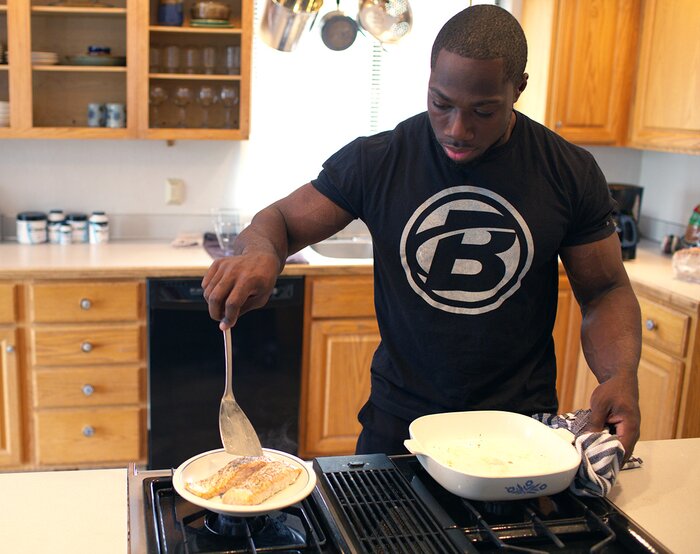
Anytime Quick Keto Meal: ”Fridge to Pan”
This is an easy way to make a tasty, keto-friendly meal—and clear out the fridge. The more variety in the ingredients, the better! Macros will vary on this one depending on the protein and veggies you use.
Add as many of the following as you’d like to a skillet with butter or olive oil:
- Protein: Ground beef, sausage, bacon, chicken, or eggs
- Veggies: Bell peppers, onion, cabbage, mushrooms, asparagus, tomato, or zucchini
- Sugar-Free Seasoning: Salt, pepper, garlic, taco, or ranch
- Cheese: Just grate it on top and let it melt.
Snack Ideas
- Jerky (Watch the carbs here, because different flavorings and sweeteners can add to the carb count quickly.)
- Cubed cheese
- Nuts and seeds
- Pork rinds
- Veggies and dip
- Sugar-free jello
- Meet Your Keto Macros
You may think you have what it takes to make the switch to keto without tracking your macronutrients, but you’re probably wrong. Getting your macros correct is the most important part of a ketogenic diet!

Here’s how keto macros end up looking for most people:
- Carbohydrates: 5-10 percent
- Fats: 70 percent
- Protein: 20-30 percent
Basically, a keto diet meal plan is a carbohydrate-restricted, high-fat, moderate-protein diet. If you’re accustomed to a protein intake close to or above your body weight in grams each day, you may be skeptical about a diet that reduces it by as much as half. Fear not.
Ketones have a ”protein sparing” effect, which means you don’t need to—and shouldn’t—take in huge quantities to still see muscle-building results. Once you gain more experience with your personal levels of ketosis, you can start playing with how much protein you consume in a day. Serious lifters and athletes end up right around 20 percent.
How to Eat for Muscle Gain and Weight Loss on the Keto Diet
Once you have your carbs and protein set, simply fill the rest of your daily calorie needs with fat, calibrating your total intake to match your fitness goal. If you want to gain a bit of weight, for example, add approximately 500 calories, or 55 grams. If you want to lose weight, cut down on your fat intake by 200-500 calories, or 22-55 grams.
Butter, nuts, coconut and olive oils, and fatty cuts of meat are all on the menu. However, don’t go overboard with polyunsaturated fats like soybean, corn, or sunflower oil. Keto dieters who increase their intake of those fats often end up with gastrointestinal distress that causes them to jump ship.
